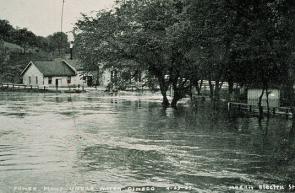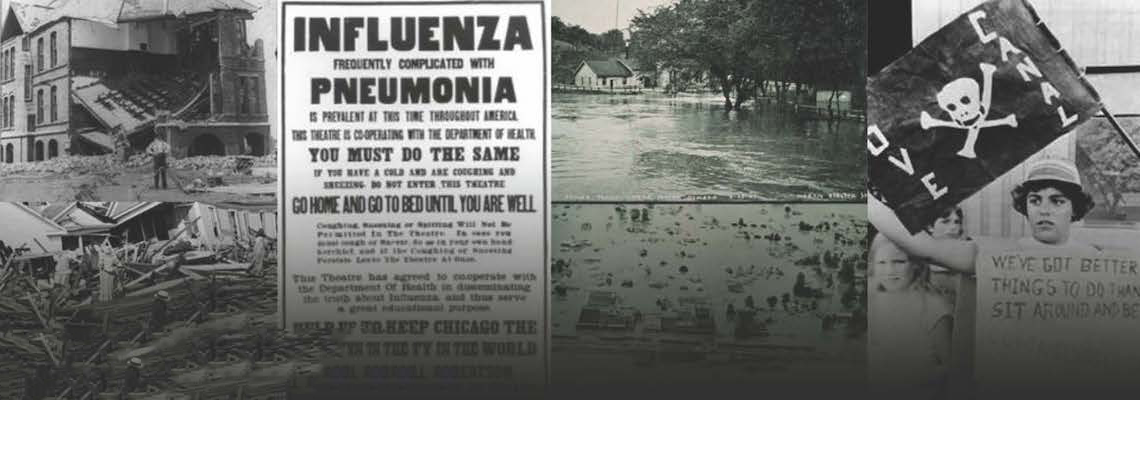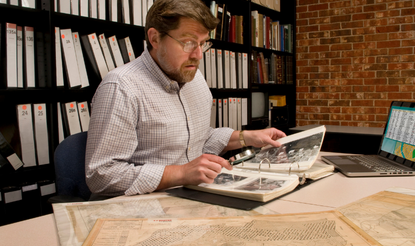The Great 1927 Mississippi River Flood
by John M. Barry
 In the latter part of August 1926, the sky darkened over much of the central United States and a heavy and persistent rain began to fall. Rain pelted first Nebraska, South Dakota, Kansas, and Oklahoma, then edged eastward into Iowa and Missouri, then into Illinois, Indiana, Kentucky, and Ohio. Lightning seemed almost to crack open the sky, booming thunder made buildings quiver, and rain poured from the sky in sheets. When this storm passed, another followed, then another.
In the latter part of August 1926, the sky darkened over much of the central United States and a heavy and persistent rain began to fall. Rain pelted first Nebraska, South Dakota, Kansas, and Oklahoma, then edged eastward into Iowa and Missouri, then into Illinois, Indiana, Kentucky, and Ohio. Lightning seemed almost to crack open the sky, booming thunder made buildings quiver, and rain poured from the sky in sheets. When this storm passed, another followed, then another.
Though the rain fell in the dry season, it saturated the soil and filled the riverbeds, drowned crops, and ruined harvests. The rivers rose. On September 1, water poured over the banks of dozens of streams and flooded towns from Carroll, Iowa, to Peoria, Illinois, three hundred and fifty miles apart. On September 4, floods deluged much of Nebraska, Kansas, Iowa, Illinois, and Indiana, killing four people. The Mississippi River itself washed out bridges and railroads in the upper Midwest. Another storm followed. Flooding stretched from Terre Haute, Indiana, to southeastern Kansas. A separate storm in northwestern Iowa dumped fifteen inches of rain in three days, sending rivers exploding over their banks, drowning ten, inundating 50,000 acres including Sioux City, and causing millions of dollars in damage. As far west as Omaha rivers rose to threatening levels.
When the rains began they had relieved the region of the summer heat. Now they were frightening. People could do nothing but watch their crops drown and their rivers rise and, reminded of their own impotence and of the power of God and nature, pray.
The rain continued into October. The Neosho River in Kansas and six hundred miles to the east the Illinois River in southern Illinois reached their highest levels in history—an extraordinary occurrence in October, when rivers normally run low. Flooding in those states was the most disastrous ever. The Mississippi at Vicksburg had only broken thirty feet on the gauge six times in history. Each time, the following spring saw a great flood on the Mississippi itself. The river at Vicksburg had never broken thirty-one feet on the gauge in October. In October 1926 it broke forty feet.
Precipitation continued into the winter over the entire Mississippi Valley, which stretches from New York to the Rockies and drains thirty-one states and two Canadian provinces. The US Weather Bureau noted that the average reading through the last three months of 1926 on every single river gauge on each of the three greatest rivers of North America—the Ohio, the Missouri, and the Mississippi itself, draining nearly one million square miles and stretching the width of the continent—was the highest ever known. The Weather Bureau later stated, "There was needed neither a prophetic vision nor a vivid imagination to picture a great flood in the lower Mississippi River the following spring."[1]
On Christmas Day 1926, both Nashville and Chattanooga—on two different rivers—flooded. On New Year’s Day 1927, the main river at Cairo, Illinois, broke flood stage, the earliest instance on record. In January Pittsburgh, Cincinnati, and Louisville flooded.
The saturated land throughout the Mississippi valley could absorb no more water, but water still came. In conjunction with the melting of a vast snowpack, virtually the entire Mississippi River system flooded in the spring of 1927, killing people from Virginia to Oklahoma.
But the greatest concern lay along the lower Mississippi, from Cairo, Illinois, to the Gulf, and tributaries feeding into that part of America. The Gulf of Mexico once reached north to present-day Cape Girardeau, Missouri, but the river system had deposited so much sediment into what geologists call the Mississippi Embayment that it had filled in the area between Cape Girardeau to the Gulf, nearly 35,000 square miles in seven states. That was the river’s natural flood plain. And there, on top of everything else, five separate rain storms struck, each one of which was greater than any single storm in the preceding ten years.
Throughout that region, only levees were in place to contain the energy of the river. The length of that levee line was well over 1,000 miles, and the great earthworks seemed an impregnable fortress, towering two and three stories above the flat delta land. It was not impregnable.
In 1927 the Mississippi reclaimed three-quarters of its flood plain, devastating Arkansas, Mississippi, and Louisiana. The statistics recounting the damage are staggering. At its widest, the river created a vast inland sea more than seventy-five miles across—one could travel the normally dry seventy miles from Vicksburg to Monroe, Louisiana, by boat. Not counting the flooding of parts of cities as large as Pittsburgh and Cincinnati, just along the lower river alone, the homes of more than 920,000 people were damaged. The nation’s population at the time was only 120 million. Roughly 1 percent—perhaps more—of the entire population of the country was flooded out of their homes. 330,000 were rescued by boat from rooftops, trees, levee crowns, and second stories.[2] Hundreds of thousands of homes and commercial buildings were destroyed. No one knows the death toll—the Red Cross claimed it was only 246 but the Weather Bureau said 500, while a professional disaster expert estimated the dead in Mississippi alone at 1,000.
But the biggest impact of the flood was less on individual communities that were inundated than on America itself. Far more than any other natural disaster, the 1927 Mississippi River flood altered the course of American history. It did this in four chief ways: it revised environmental management, propelled a dark horse to the presidency, altered the political landscape for African Americans, and expanded the role of government in crises.
River Management
First, and most directly, the flood settled an engineering argument over how to handle rivers. The US Army Corps of Engineers had pursued what it called a "levees-only" policy toward flood protection, refusing to use reservoirs to prevent water from entering the river. This was based on a theory that increasing the amount of water in the river would increase its current, which in turn would pick up sediment from the river bottom, deepening it enough to accommodate a flood. But a leading Corps scientist, who became the chief of the Corps of Engineers, had run experiments and concluded that "the investigations . . . have rendered untenable that position [that] the exclusive use of levees . . . lowered the flood by deepening the bed."[3]
Why the Corps followed the levees-only policy in defiance of all scientific evidence is a classic case study of bureaucracy and turf warfare. But the 1927 flood ended the debate about the Mississippi and all great rivers. Henceforth engineers recognized that rivers had to be accommodated and could not be constrained. The success of this approach was demonstrated in 2011, when another great flood came down the Mississippi and put 10,000 square miles under water—virtually all of it by design, in floodways used for farming.
A Dark Horse Is Propelled to the Presidency
The 1927 flood also made Herbert Hoover president of the United States. An enormously wealthy engineer, Hoover developed and owned mines and oil fields in America, Russia, China, Australia, South America, and Africa. But for all his wealth, he had no political base. How could he? Hoover had left the United States after graduating Stanford and did not return until the US entered World War I; he had not even voted in a presidential election until 1920. Nonetheless he wanted to be president. A logistical genius, he had organized American food production and distribution during World War I and fed much of Europe in the immediate aftermath of the war. John Maynard Keynes said he was "the only man who emerged from the ordeal [of the peace conference] with an enhanced reputation." He became known as "The Great Humanitarian." Using his own wealth, he sought the Republican presidential nomination in 1920. His campaign was mocked, and he received no support. But President Warren G. Harding named him Secretary of Commerce, and in 1927, President Calvin Coolidge put him in charge of the response to the flood.
The flood was the biggest story of the year and it lasted for weeks, through several crests, the rescue of populations, and recovery planning. Hoover and his staff worked diligently to exploit the coverage; no newspaper was too small. Hoover personally communicated with weekly papers from Arizona and Texas to Washington State, Nebraska, and Indiana. In evaluating his strategy, the present-day political commentator James Carville concluded that "Hoover had a better press operation than any politician I know today." Routinely, the press hailed Hoover as a hero and a savior; a California paper proclaimed, "He is the ablest and most efficient American in public life . . . In personal fitness for the presidency there is no other American, even remotely, in Mr. Hoover’s class."[4]
Coverage like that prompted Hoover to confide to a friend, "I shall be the nominee, probably. It is practically inevitable."[5]
Hoover’s confidence was not based on the media alone. He finally had a political base. That base was among African Americans, who then overwhelmingly voted Republican. While African Americans were not a major political force in the country, they played two important roles.
When scandals had threatened to break over the distribution of flood aid to African Americans, Hoover turned to Robert Moton to keep a lid on the scandal. Moton had succeeded Booker T. Washington as head of both the Tuskegee Institute and "the Tuskegee Machine," the political operation that generally exercised near veto power over appointments of southerners by Republican presidents.
African Americans generally and Moton personally also played an important role at the 1928 Republican National Convention for Hoover. Although African Americans could not vote in most elections in the South, they often controlled the Republican Party in southern states. And there was one place they could vote—at the Republican National Convention for the presidential nominee. When Hoover promised Moton that he would break up large plantations and make sharecroppers landowners, an ecstatic Moton told other African American leaders this would be "more significant than anything which has happened since Emancipation ."
Moton was in charge of black delegates to the convention, and this virtually guaranteed Hoover a base. With help from African Americans, the push from the media, and Moton’s successful efforts to suppress scandal, Hoover won the GOP nomination on the first ballot and easily went on to win the 1928 presidential election.
African Americans Shift from the Party of Lincoln
The aftermath of the flood soon prompted the shift of African American voters away from the Republican Party. Ironically, this shift began with Hoover’s historic 1928 landslide win. Since Reconstruction, no Republican presidential candidate had carried a single southern state. Largely because the 1928 Democratic candidate Al Smith was Catholic, Hoover carried five: Texas, Tennessee, Virginia, Florida, and North Carolina. As a result, GOP political operatives saw the possibility of creating a Republican Party in the South that could compete with the Democrats. Since African Americans could not vote in the South, that party would be all white.
After the election, Robert Moton’s influence in the Hoover camp eventually declined, and Hoover turned away from the base that had won him his office. Hoover even nominated a man to the Supreme Court so racist that a Senate controlled by his own party rejected the nominee. To Moton’s great disappointment, Hoover abandoned his proposal to transform sharecroppers into landowners. Moton and other black political leaders regarded this as a personal betrayal; that and the GOP’s outreach to white southerners ended many African Americans’ emotional connection to the party of Lincoln.
In 1932, Moton said that if Franklin Roosevelt "has done anything for the Negro as Governor of New York, I have not heard of it."[6] But he refused to endorse Hoover for reelection. Hoover still received a large majority of the black vote, but respect for him was gone.
The Role of Government in a Crisis
The most important effect of the 1927 flood was also the most subtle: it changed the way Americans viewed government’s responsibility in a time of crisis.
Although there is no scientific data on the question, it seems, based on existing policy and newspaper editorial commentary, that most Americans in the 1920s felt the government had no responsibility to provide any direct assistance to individuals. There was certainly a widespread sense that people who sought government help were at best weak and at worst immoral, and government policy reflected such sentiments. In 1905 a yellow fever epidemic erupted in New Orleans. Public health experts knew how to contain yellow fever, but before Theodore Roosevelt’s administration would send public health experts to help, it required New Orleans to pay $250,000 in advance to cover the expenses. And in 1922, when a flood in Louisiana had made 40,000 homeless, Governor John Parker refused even to ask the Red Cross for help, saying, "Louisiana has issued no call for aid and will not."[7]
That attitude was reflected in federal policy toward flood relief. In 1927, the Red Cross fed over 600,000 people, some for a year, and more than 300,000 lived as refugees in tent cities. All the money for this was raised privately. Not only did the federal government spend nothing to feed, clothe, and shelter these people, the army demanded reimbursement from the Red Cross for use of its tents and field kitchens.
When it came to recovery, the story was the same. To help these people and the devastated states recover—the agricultural economy in parts of seven states and the banks which had financed the agriculture were destroyed—the federal government spent nothing. Coolidge not only ignored numerous pleas to visit the flooded territory, but refused even to autograph pictures of himself to be auctioned off at fundraisers. The Red Cross gave people departing refugee camps who had lost absolutely everything—every piece of furniture, every cooking utensil, every tool, every farm animal—goods and seeds worth less than $20. Hoover personally urged bankers and big businessmen to privately finance recovery efforts, but the government did nothing.
By and large, Americans thought this was wrong. Months of media coverage of hundreds of thousands of desperate Americans seemed to change the country’s view of government’s role. In 1927 John Parker, no longer governor of Louisiana, was in charge of the state’s recovery. In 1922 he had refused to seek aid. Now, with 200,000 Louisianans homeless and destitute, he asked for all the aid he could get from every quarter. That reversal in attitude was also demonstrated by the one source of public opinion that is measurable: newspaper editorials. Hoover’s staff combed hundreds of newspapers and reported that, whether papers were Democratic or Republican, "at least four-fifths of the editorials coming in" demanded federal action. "There continues to be considerable criticism of the attitude of the President."[8]
Because of Coolidge’s intense opposition, Congress did not act to directly help individuals or businesses. But in 1928 Congress did pass a massive flood control act—the most expensive domestic program the federal government had ever launched—which set a precedent in reordering state and federal responsibility.
The flood had other effects. It spurred black migration out of the South, reordered regional and national power structures, influenced the blues. It had more substantive impact on the nation than any other disaster in US history. Yet it is less well known than the San Francisco earthquake, the Chicago fire, even the Johnstown flood. That fact in itself is a lesson; to understand history, one must look deep.
[1] US Army Corps of Engineers, Annual Report of the Chief of Engineers for 1926 (Washington, 1926), p. 1793.
[2] Marion Bragg, Historic Names and Places on the Lower Mississippi River (Vicksburg: Mississippi River Commission, 1977), p. 91.
[3] Andrew Atkinson Humphreys and Henry Abbot, Report on the Physics and Hydraulics of the Mississippi River; Upon the Protection of the Alluvial Region Against Overflow; and Upon the Deepening of the Mouths . . . , (Philadelphia, 1861), pp. 30, 186, 387, 404-407.
[4] "The Mississippi Flood and Mr. Hoover’s Part in Relief Work," news summaries for May 23, 1927, Hoover Library.
[5] Craig Lloyd, Aggressive Introvert: A Study of Herbert Hoover and Public Relations Management, 1912–1932, (Columbus, Ohio: Ohio State University Press, 1972), p. 84.
[6] Donald Lisio, Hoover, Blacks, and Lily Whites: A Study of Southern Strategies (Chapel Hill: UNC Press, 1985), p. 269.
[7] New Orleans Times Picayune, April 29, 1922.
[8] Press summary, undated early June (probably June 7), and June 17, 1927, Hoover Library.
John M. Barry is a best-selling historian. His book, Rising Tide: The Great Mississippi Flood of 1927 and How It Changed America, published by Simon and Schuster, won the Francis Parkman Prize of the Society of American Historians for the year’s best book in 1998. In 2005, the New York Public Library listed Rising Tide as one of the 50 best books of the preceding 50 years.



